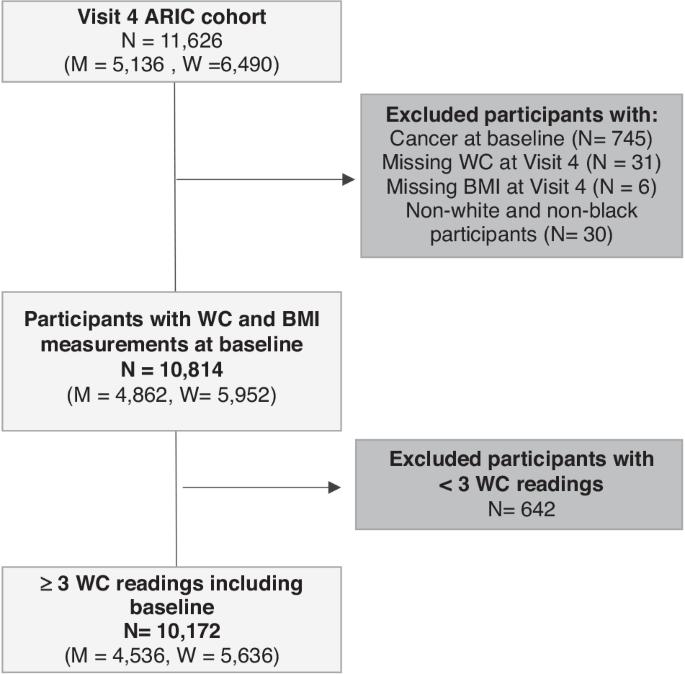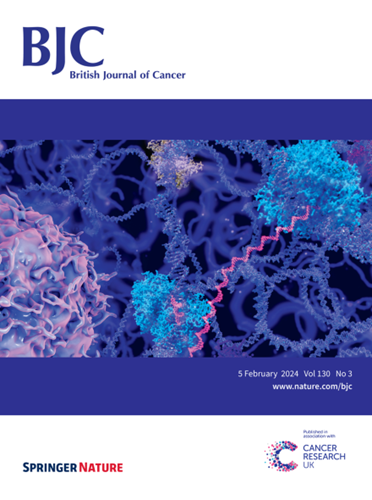腰围年数与癌症风险:一项前瞻性研究,探讨腰围与体重指数之间的关联并比较其预测性能。
IF 6.4
1区 医学
Q1 ONCOLOGY
引用次数: 0
摘要
背景:研究了一次或长期测量的腰围(WC)和体重指数(BMI)与癌症发病率的关系。腰围与某些癌症的关系与体重指数无关。目前还缺乏对累积性中心脂肪与癌症的分析。我们研究了男性腰围≥102厘米或女性腰围≥88厘米的暴露时间与癌症之间的关系,并将其与单次腰围或体重指数进行了比较:方法:在前瞻性社区动脉粥样硬化风险研究(ARIC)中连续测量 9 年的 WC 值可预测每年的 WC 值。Cox 比例危险回归估算了第 4 次测量的腰围-年、腰围或体重指数与癌症发病率的危险比 (HRs)。哈雷尔 C 统计量量化了指标预测性能:10,172 名参与者从第 4 次就开始接受癌症随访,男性随访时间中位数为 13.7 年,女性随访时间中位数为 15.8 年。对于肥胖相关癌症,每标准差腰围-年的HR值分别为1.14(95%CI:1.04,1.25)和1.19(95%CI:1.12,1.27)。指标预测性能的差异微乎其微:这是首次发现腰围年数与癌症之间存在正相关关系的研究。除腰围和体重指数外,腰围年数并不能提供癌症风险的额外信息。BMI是临床上的常规测量方法,因此可能比腰围更受青睐。本文章由计算机程序翻译,如有差异,请以英文原文为准。

Waist circumference-years and cancer risk: a prospective study of the association and comparison of predictive performance with waist circumference and body mass index
Associations of waist circumferences (WC) and body mass index (BMI) measured once or over time, with cancer incidence were studied. WC is associated with some cancers independent of BMI. Analyses of cumulative central adiposity and cancer are lacking. We investigated associations between waist circumference-years, incorporating exposure time to WC ≥ 102 cm in men or ≥88 cm in women, and cancer, and compared this with single WC or BMI. Serial WC measurements taken over 9 years in the prospective Atherosclerosis Risk in Communities Study (ARIC) predicted yearly WC. Cox proportional hazards regression estimated hazard ratios (HRs) of cancer incidence for waist circumference-years, WC or BMI, measured in Visit 4. Harrell’s C-statistic quantified metric predictive performances. 10,172 participants were followed up from Visit 4 for cancer over a median 13.7 for men and 15.8 years for women. For obesity-related cancers, HRs per standard deviation waist circumference-years were 1.14 (95%CI:1.04,1.25) and 1.19 (95%CI:1.12,1.27), respectively. Differences in metric predictive performances were marginal. This is the first study to identify positive associations between waist circumference-years and cancer. Waist circumference-years did not provide additional information on cancer risk beyond that of WC and BMI. BMI is routinely measured in clinic so it may be preferred over WC.
求助全文
通过发布文献求助,成功后即可免费获取论文全文。
去求助
来源期刊

British Journal of Cancer
医学-肿瘤学
CiteScore
15.10
自引率
1.10%
发文量
383
审稿时长
6 months
期刊介绍:
The British Journal of Cancer is one of the most-cited general cancer journals, publishing significant advances in translational and clinical cancer research.It also publishes high-quality reviews and thought-provoking comment on all aspects of cancer prevention,diagnosis and treatment.
 求助内容:
求助内容: 应助结果提醒方式:
应助结果提醒方式:


